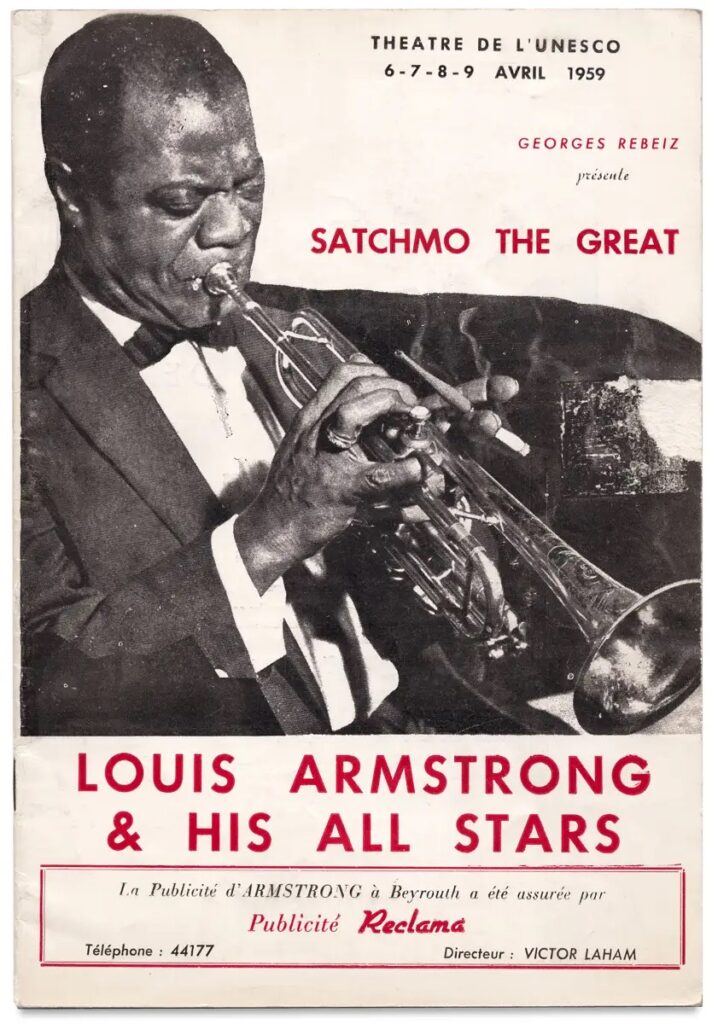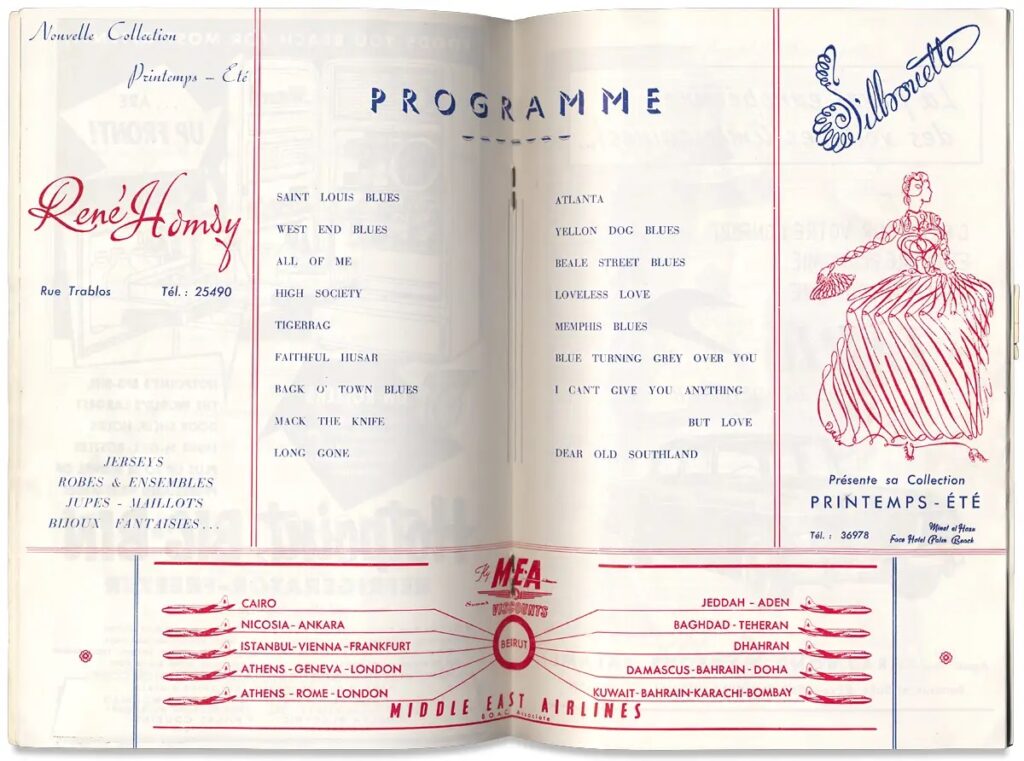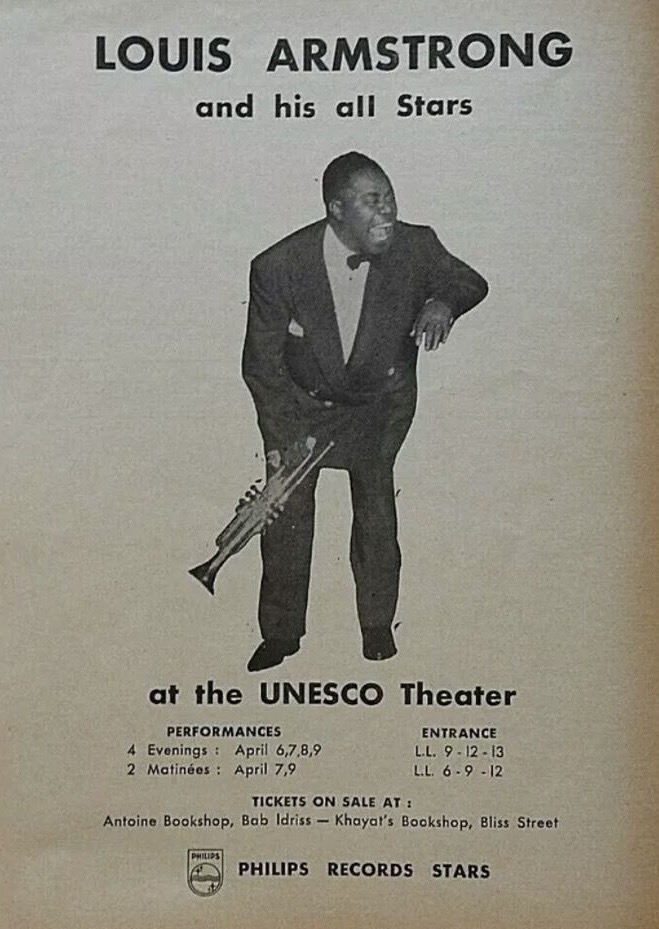Swingin’ Through the Cedars: When Louis Armstrong Visited Beirut

By: Ralph I. Hage / Arab America Contributing Writer
In April of 1959, the Lebanese capital of Beirut welcomed a musical legend whose visit would resonate for decades. Louis Armstrong, the renowned trumpeter and vocalist known worldwide as “Satchmo,” brought his distinctive brand of jazz to a city eager for cultural connections. More than just a concert tour, Armstrong’s time in Beirut represented a meaningful exchange between East and West during a transformative era in global politics and music.
Beirut – A Cultural Hub

Beirut, in the 1950s, was experiencing a golden age. Renowned for its vibrant arts scene, unique architecture, and unrivaled nightlife, the city was becoming a hub for international culture. When news broke that Louis Armstrong would perform there, it created a stir in the local music scene.
Upon his arrival at Beirut Airport with his wife Lucille and his All-Stars band, Armstrong was greeted with great fanfare. The media had been abuzz for weeks leading up to the event, and by the time the concerts began at the UNESCO Palace, every ticket had been snapped up. From April 6 to 9, sold-out crowds witnessed what would become one of the most unforgettable series of live jazz performances in Lebanon’s history.
Jazz Messengers

Though the U.S. State Department didn’t officially organize Armstrong’s tour through the Middle East, it aligned with America’s broader use of jazz as a form of international outreach during the Cold War. The U.S. government had been sending jazz musicians overseas as cultural ambassadors, promoting values like freedom of expression and diversity through music.
Armstrong had a nuanced relationship with these efforts. A few years earlier, he had refused to participate in a State Department tour in protest of segregation and racial injustice back home. By the time he visited Beirut, he was touring independently, but his presence alone carried powerful symbolism—particularly in a region often skeptical of U.S. foreign policy. For many Lebanese, seeing a Black American artist of Armstrong’s stature perform live was an eye-opening experience. It presented a different image of America than what was typically portrayed in politics or media, and it helped bridge cultural gaps that other mediums could not.
Performances That Dazzled a Nation

Each evening at the UNESCO Palace, Armstrong and his band delivered a high-energy mix of jazz classics and popular standards. Songs like “All Of Me,” “Mack the Knife,” and “I Can’t Give You Anything But Love” filled the auditorium, with audiences responding enthusiastically – by clapping in rhythm, dancing in the aisles, and calling for encores.
Armstrong’s trumpet solos dazzled, but many of those who attended said it was his stage presence – his warmth, humor, and obvious love for the music – that made the experience especially memorable.
Offstage Encounters and Local Life

‘Armstrong In Beirut’ — from the concert pamphlet. Source: Hage Family Collection
Armstrong and Lucille didn’t just perform and retreat to their hotel. They immersed themselves in the city’s culture. They visited local markets, including the lively Souk al-Tawileh in Beirut, where Lucille reportedly shopped for souvenirs. Their hosts recalled how approachable and kind the couple were, enjoying Beirut’s hospitality with genuine appreciation.
Cecile Geammal, then a key figure in Lebanon’s jazz community, later described Armstrong as gracious and grounded. The way he and Lucille interacted with locals – laughing, sharing meals, exploring the city – demonstrated that they saw this trip as more than a tour; it was a chance to connect.
One especially telling moment came when Armstrong was asked about the political sensitivities of performing in different parts of the Middle East. He replied with a simple, poignant truth: “That horn ain’t prejudiced. A note’s a note in any language.”
Turbulence in the Background
While Beirut embraced Armstrong with open arms, not every part of the region welcomed him as warmly. In Egypt, certain publications accused him of being involved in espionage – an accusation that had no basis. These claims reflected the political tensions of the time and the suspicion often directed at high-profile Western visitors.
Armstrong, however, paid little attention to the noise. His focus remained on sharing his music.
A Legacy That Still Echoes

When Armstrong left Lebanon, he didn’t just leave behind a few concert posters and press clippings. His visit helped establish jazz as a serious art form in the region and planted seeds for Lebanon’s cultural scene to grow.
Even decades later, his time in Beirut remains a cherished memory for those who were there and a cultural milestone for the city. His performances are remembered not just for their brilliance but for what they represented: hope, joy, and the power of music to connect people across borders, backgrounds, and beliefs.
One great example of that was Armstrong’s message to the Lebanese people over the radio upon arriving at Beirut Airport. In that famous gravelly voice, he spoke in Arabic and said:
انا مبسوط كثير اكون في لبنان!
Listen to it here.
Ralph Hage is a Lebanese American architect who divides his time between Lebanon and the United States.
Want more articles like this? Sign up for our e-newsletter!
Check out our blog here!








